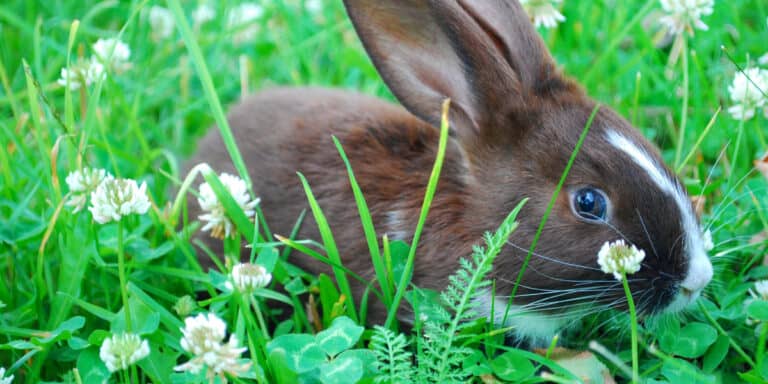When it comes to successful bunny breeding, think of it as a delicate dance where each move must be precise and well-executed.
You're about to uncover the essential secrets that can make or break your breeding endeavors. From selecting the perfect pairs to maneuvering the intricacies of pregnancy care, each step plays a crucial role in ensuring a fruitful outcome.
Stay tuned to unravel the mysteries behind successful bunny breeding and set yourself on the path to becoming a skilled breeder in no time.
Contents
Key Takeaways
- Match rabbits based on size and breed characteristics for successful breeding.
- Monitor mating behaviors closely and breed rabbits twice a day for optimal fertilization.
- Provide proper pregnancy care with a comfortable nesting area and balanced diet.
- Monitor newborn kits closely, ensuring warmth, feeding, and cleanliness for their well-being.
Selecting Suitable Breeding Pairs

When selecting suitable breeding pairs for rabbits, match individuals of similar size and breed characteristics to guarantee successful breeding outcomes. It's important to avoid crossbreeding large and small rabbit breeds as this can lead to complications during mating and birthing.
Instead, consider in-line breeding to enhance desirable traits while maintaining genetic diversity. By carefully selecting breeding pairs based on specific goals, such as fur color or temperament, you can make sure that the offspring meet your expectations.
Compatibility in temperament between the breeding pair is essential to prevent aggression during mating, which can hinder the breeding process. By focusing on breeding pairs with similar sizes, breed characteristics, and compatible temperaments, you increase the likelihood of successful mating and healthy offspring.
Ensuring Proper Mating Techniques
To guarantee successful rabbit breeding, it's essential to employ proper mating techniques to maximize fertilization and conception rates. When introducing rabbits for mating, make it in a neutral space to reduce stress and increase the likelihood of successful breeding. Monitor mating behaviors closely, such as mounting and receptive postures, to confirm that mating is occurring correctly. Breeding twice a day can enhance the chances of successful fertilization and conception in rabbits.
Avoid leaving rabbits together for extended periods as this can lead to territorial aggression and potential injuries during mating. It's important to observe signs of pregnancy in does post-mating to provide proper care and monitor the breeding process effectively. By following these proper mating techniques and being attentive to the behaviors of the rabbits, you can increase the likelihood of a successful breeding outcome.
Managing Pregnancy Care Effectively

For effective management of pregnancy care in rabbits, providing a comfortable nesting area with soft bedding materials is important. Make sure that the doe has a suitable nesting box where she can make her nest before giving birth.
Throughout the Gestation Period, monitor the pregnant doe closely for any signs of distress or complications. It's important to make sure that the pregnant doe has continuous access to fresh water and a balanced diet to support her health and the development of the kits.
Be prepared to assist the pregnant doe during labor if necessary, particularly if she's a first-time mother. Creating a calm and quiet environment for the pregnant doe is essential to minimize stress and promote a successful pregnancy and birthing process.
Handling Litter Birth and Nesting
When assisting a pregnant doe during labor, providing a calm and quiet environment is essential for a successful birthing process. Set up a nest box with soft bedding to offer a comfortable and secure space for the mother rabbit to give birth. Monitor her closely as she pulls fur from her chest to line the nest, ensuring a perfect environment for the newborn kits.
Avoid excessive handling of the kits in the initial days to prevent stress on the mother and maintain bonding within the litter. Regularly check the newborn kits to guarantee they're warm, well-fed, and growing adequately, addressing any concerns promptly. Keep the nesting area clean and draft-free to create a healthy and safe space for both the kits and the mother rabbit.
Following these practices will help create an excellent environment for successful litter birth and nesting.
Addressing Post-Birth Litter Care

Regularly monitoring the doe after birth is important to make sure she maintains proper hygiene and care for her newborn kits. Here are some essential steps to address post-birth litter care in raising rabbits:
- Check the Kits: Monitor the kits daily to guarantee they're nursing and growing. If any kit appears weak or neglected, intervene by providing supplemental feeding or seeking veterinary assistance.
- Maintain Cleanliness: Keep the nest boxes clean and dry to prevent infections and maintain a healthy environment for the kits' growth and development.
- Provide Adequate Nutrition: Guarantee the doe has access to fresh water immediately after giving birth and offer a balanced diet to support her milk production and the kits' nutritional needs.
- Monitor Kit Development: Keep an eye on the kits' progress as they grow. Around 10 days after birth, they'll start opening their eyes, indicating their readiness to explore beyond the nest box.
Frequently Asked Questions
How Do You Successfully Breed Rabbits?
To successfully breed rabbits, maintain a breeding schedule aligned with the breeding season. Select breeding pairs with care, ensuring genetic compatibility. Set up cages appropriately, follow a feeding regimen, conduct health checks, prepare nests, handle rabbits gently, and monitor behavior closely.
What Should You Do Before Breeding Rabbits?
Before breeding rabbits, confirm proper nutrition, health checks, and genetic compatibility. Check housing, environmental factors, and breeding age. Monitor behavior and maintain breeding records. Separate after mating to avoid stress. Bonding is important.
What Are the Qualities of a Good Rabbit Breeding?
To excel in rabbit breeding, guarantee genetic diversity, maintain a healthy diet, provide proper housing, offer regular exercise, conduct temperament testing, foster pair bonding, schedule veterinary check-ups, breed at the appropriate age and season, and exhibit patience and care.
How Can I Make My Rabbit Fertile?
To make your rabbit fertile, guarantee a balanced diet, proper exercise, regular health checks, and mating at the right age. Monitor hormone levels, select suitable mates, follow a careful breeding process, provide pregnancy care, prepare a nest, and offer proper care to newborns.
Conclusion
In summary, by carefully following the 5 essential secrets for successful bunny breeding, you have now revealed the ultimate guide to becoming a bunny breeding master.
With your newfound knowledge and dedication, you're on the path to achieving unparalleled success in the world of rabbit breeding.
Remember, attention to detail and proper care are the keys to ensuring thriving and healthy bunny offspring.
Embrace these secrets, and watch your bunny breeding endeavors flourish beyond imagination.






